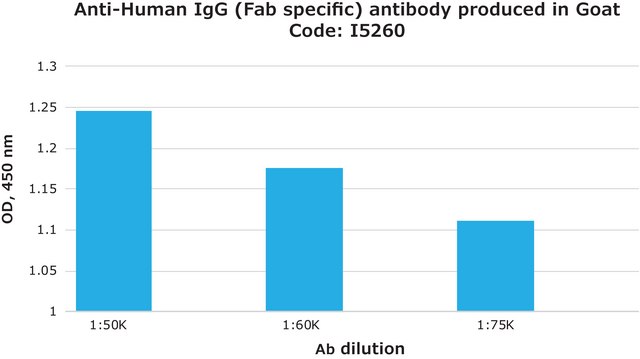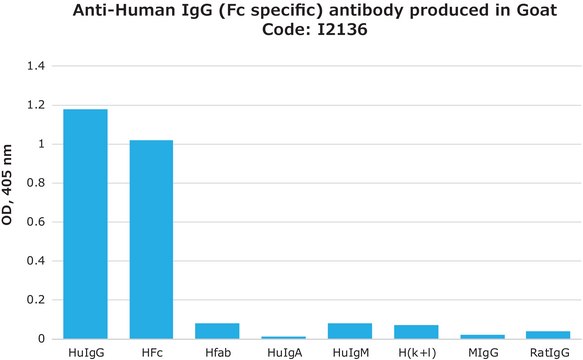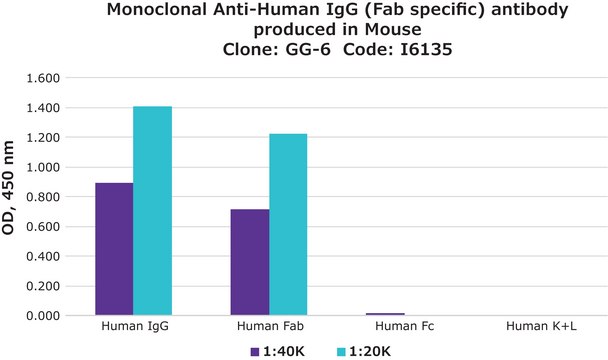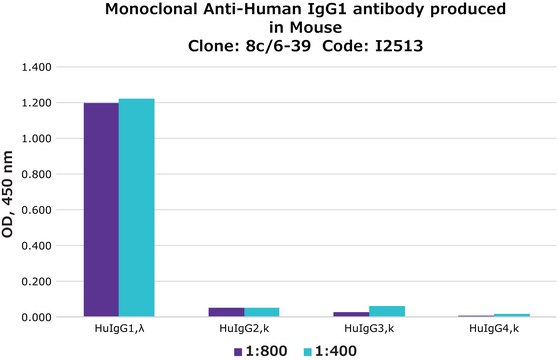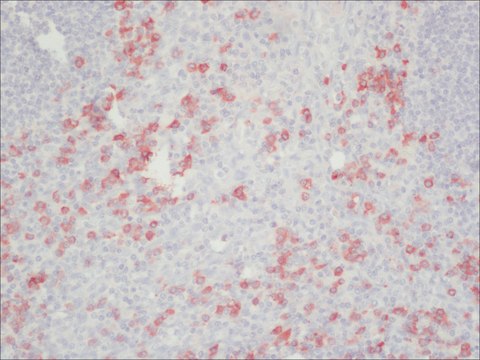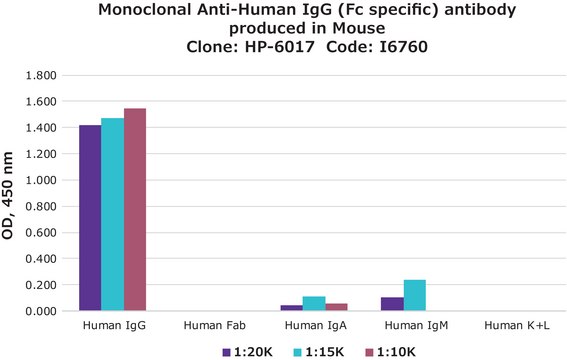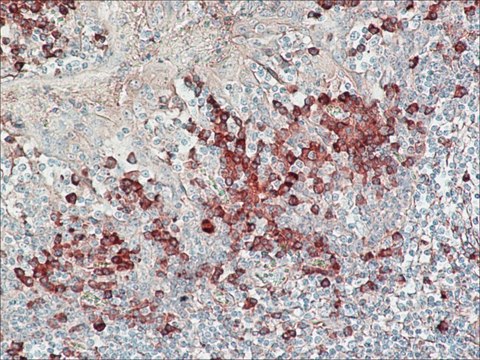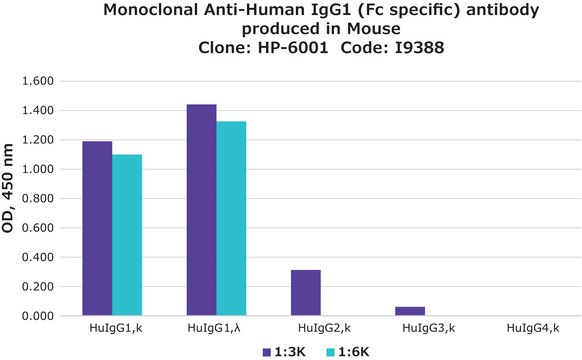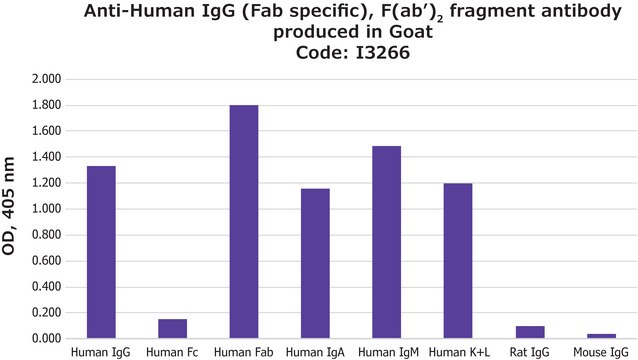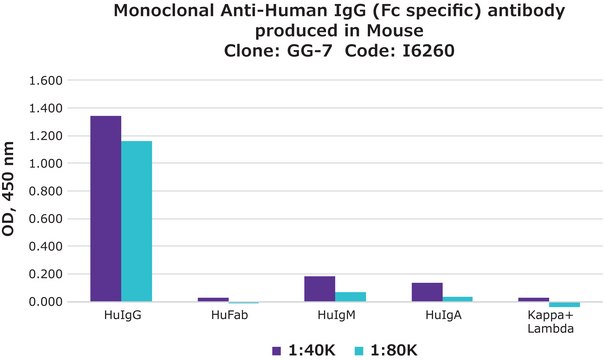I5385
Monoclonal Anti-Human IgG1 (Fab specific) [G1m(f)] antibody produced in mouse
clone SG-16, ascites fluid
Sign Into View Organizational & Contract Pricing
All Photos(1)
About This Item
Recommended Products
biological source
mouse
Quality Level
conjugate
unconjugated
antibody form
ascites fluid
antibody product type
secondary antibodies
clone
SG-16, monoclonal
contains
15 mM sodium azide
technique(s)
indirect ELISA: 1:5,000
isotype
IgG1
shipped in
dry ice
storage temp.
−20°C
target post-translational modification
unmodified
General description
Monoclonal Anti-Human IgG1 (mouse IgG1isotype) is derived from the hybridoma produced by the fusion of mouse myeloma cells and splenocytes from an immunized mouse. Human IgGs are glycoprotein antibodies that contain two equivalent light chains and a pair of identical heavy chains. IgGs have four distinct isoforms, ranging from IgG1 to IgG4.
Immunogen
Purified human IgG
Application
Monoclonal anti-Human IgG1 may be used for the identification of human IgG1 subclass by means of various immunoassays. It can be used in direct hemagglutination (HA) and hemagglutination inhibition (HAI) assays, immunofluorometric assay (IFMA) and detection of cytoplasmic IgG. Monoclonal anti-human IgG1 has been used in enzyme linked immunosorbent assay (ELISA).
Biochem/physiol Actions
Human IgGs regulate immunological responses to allergy and pathogenic infections. IgGs have also been implicated in complement fixation and autoimmune disorders This product clone recognizes the G1m(f) allotype and has been established as a useful human IgG1 specificity standard by the WHO/IUIS study.
Disclaimer
Unless otherwise stated in our catalog or other company documentation accompanying the product(s), our products are intended for research use only and are not to be used for any other purpose, which includes but is not limited to, unauthorized commercial uses, in vitro diagnostic uses, ex vivo or in vivo therapeutic uses or any type of consumption or application to humans or animals.
Not finding the right product?
Try our Product Selector Tool.
Storage Class Code
10 - Combustible liquids
WGK
nwg
Flash Point(F)
Not applicable
Flash Point(C)
Not applicable
Regulatory Information
常规特殊物品
Choose from one of the most recent versions:
Certificates of Analysis (COA)
Lot/Batch Number
Don't see the Right Version?
If you require a particular version, you can look up a specific certificate by the Lot or Batch number.
Already Own This Product?
Find documentation for the products that you have recently purchased in the Document Library.
Andreas Lossius et al.
Annals of clinical and translational neurology, 4(10), 756-761 (2017-10-20)
Immunoglobulin gamma (IgG) heavy chain genes are associated with susceptibility to multiple sclerosis (MS) and IgG levels in the cerebrospinal fluid (CSF). However, how these variants are implicated in disease mechanisms remains unknown. Here, we show that proliferating plasmablasts expressing
Recurrence of monoclonal gammopathy associated with donor-derived myelodysplastic syndrome after cord blood stem cell transplantation
Yamazaki R, et al.
Experimental Hematology, 39(12), 1119-1123 (2011)
Allotype analysis to distinguish the origin of varicella-zoster virus immunoglobulin G after allogeneic stem cell transplantation
Yamazaki R, et al.
Biology of Blood and Marrow Transplantation : Journal of the American Society For Blood and Marrow Transplantation, 19(7), 1013-1020 (2013)
Kenneth A Rogers et al.
Journal of immunology (Baltimore, Md. : 1950), 177(6), 3848-3856 (2006-09-05)
Ig Fc receptors bind to immune complexes through interactions with the Fc regions of specific Ab subclasses to initiate or inhibit the defense mechanisms of the leukocytes on which they are expressed. The mechanism of action of IgG-based therapeutic molecules
Asia-Sophia Wolf et al.
Vaccine, 40(50), 7201-7210 (2022-10-10)
Childhood pneumococcal conjugate vaccine (PCV) protects against invasive pneumococcal disease caused by vaccine-serotype (VT) Streptococcus pneumoniae by generating opsonophagocytic anti-capsular antibodies, but how vaccination protects against and reduces VT carriage is less well understood. Using serological samples from PCV-vaccinated Malawian
Our team of scientists has experience in all areas of research including Life Science, Material Science, Chemical Synthesis, Chromatography, Analytical and many others.
Contact Technical Service